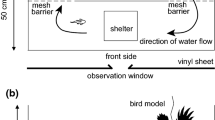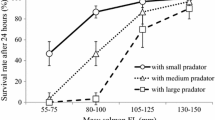Abstract
We investigated the effects of body color luminance and behavioral characteristics of stocked juvenile white-spotted charr, masu salmon, rainbow trout, albino rainbow trout, and non-spotted rainbow trout on their predation risk by predatory land animals. Body color luminance and behavioral characteristics were scored before starting the predation test. The dorsal color luminance of the albino rainbow trout was brighter than that of the other fish. The white-spotted charr and non-spotted rainbow trout were less active than the masu salmon and rainbow trout, and the non-spotted rainbow trout stayed in the open more than the white-spotted charr during behavioral observations in an aquarium. A piscivorous bird, the grey heron was the most frequently observed land animal during the predation test conducted at a semi-natural stream study site. The survival rate of total fish groups was 21.4 %, only 3 % albino rainbow trout and 11 % non-spotted rainbow trout survived, which were significantly lower than the survival rate of the other fish. These results suggest that the body color luminance of albino rainbow trout and the behavioral characteristics of non-spotted rainbow trout were important vulnerability factors.





Similar content being viewed by others
References
Abrahams, M. V. & M. C. Healey, 1993. A comparison of the relative willingness of four species of Pacific salmon to risk exposure to a predator. Oikos 66: 439–446.
Adriaenssens, B. & J. I. Johnsson, 2011. Shy trout grow faster: exploring the links between personality and fitness-related traits in the wild. Behavioral Ecology 22: 135–143.
Alexander, G. R., 1979. Predators of fish in coldwater streams. Predator–prey systems in fisheries management. In Stroud, H. R. & H. Clepper (eds.), Proceedings of the international symposium on predator-prey systems in fish communities and their role in fisheries management. Sport Fishing Institute, Washington, DC: 153–170.
Bridges, W. R. & B. von Limbach, 1972. Inheritance of albinism in rainbow trout. The Journal of Heredity 63: 152–153.
Brown, G. E. & R. J. F. Smith, 1998. Acquired predator recognition in juvenile rainbow trout (Oncorhynchus mykiss): conditioning hatchery-reared fish to recognize chemical cues of a predator. Canadian Journal of Fisheries and Aquatic Sciences 55: 611–617.
Childs, H. E., 1953. Selection by predation on albino and normal spadefoot toads. Evolution 7: 228–233.
Collis, K., D. D. Roby, D. P. Craig, S. Adamany, J. Y. Adkins & D. E. Lyons, 2002. Colony size and diet composition of piscivorous waterbirds on the lower. Columbia River: Implications for losses of juvenile salmonids to avian predation. Transactions of the American Fisheries Society 131: 537–550.
Dobosz, S., K. Kohlmann, K. Goryczko & H. Kuzminski, 1999. Growth and vitality in yellow forms of rainbow trout. Journal of Applied Ichthyology 16: 117–120.
Dolloff, C. A., 1993. Predation by river otters (Lutra canadensis) on juvenile Coho Salmon (Oncorhynchus kisutch) and Dolly Varden (Salvelinus malma) in southeast Alaska. Canadian Journal of Fisheries and Aquatic Sciences 50: 312–315.
Donnelly, W. A. & F. G. Whoriskey, 1991. Background-color acclimation of brook trout for crypsis reduces risk of predation by hooded mergansers Lophodytes cucullatus. North American Journal of Fisheries Management 11: 206–211.
Dunham, R. A. & W. F. Childers, 1980. Genetics and implications of the golden morph in green sunfish. The Progressive Fish Culturist 42: 160–163.
Eriksson, M. O. G., 1985. Prey detect ability for fish-eating birds in relation to fish density and water transparency. Ornis Scandinavica 16: 1–7.
Ferrari, M. C. O., M. A. Vavrek, C. K. Elvidge, B. Fridman, D. P. Chivers & G. E. Brown, 2008. Sensory complementation and the acquisition of predator recognition by salmonid fishes. Behavioral Ecology and Sociobiology 63: 113–121.
Frechette, D., A. M. K. Osterback, S. A. Hayes, J. W. Moore, S. A. Shaffer, M. Pavelka, C. Winchell & J. T. Harvey, 2015. Assessing the relationship between Gulls Larus spp. and Pacific Salmon in Central California using radiotelemetry. North American Journal of Fisheries Management 35(4): 775–788.
Gawlik, D. E., 2002. The effects of prey availability on the numerical response of wading birds. Ecological Monographs 72: 329–346.
Haberman, S. J., 1973. The analysis of residuals in cross-classified tables. Biometrics 29: 205–220.
Harvey, B. C. & R. J. Nakamoto, 2013. Seasonal and among-stream variation in predator encounter rates for fish prey. Transactions of the American Fisheries Society 142: 621–627.
Heggenes, J. & R. Borgstrøm, 1988. Effect of mink, Mustela vison Schreber, predation on cohorts of juvenile Atlantic Salmon, Salmo salar L., and Brown Trout, S. trutta L., in three small streams. Journal of Fish Biology 33: 885–894.
Ishii, Y., S. Koyama & K. Imaizumi, 1980. On the culture of spotless rainbow trout. Suisanzoshoku 28: 128–133. (in Japanese).
Johnsson, J. I. & M. V. Abrahams, 1991. Interbreeding with domestic strain increases foraging under threat of predation in juvenile steelhead trout (Oncorhynchus mykiss): an experimental study. Canadian Journal of Fisheries and Aquatic Sciences 48: 243–247.
Katzir, G. & J. Camhi, 1993. Escape response of black mollies (Poecilia sphenops) to predatory dives of a pied kingfisher (Ceryle rudis). Copeia 3: 549–553.
Klein, M. L., 1993. Waterbird behavioral responses to human disturbances. Wildlife Society Bulletin 21: 31–39.
Kruuk, H., 1995. Wild Otters. Predation and Populations. Oxford University Press, New York.
Kushlan, J. A., 1976. Wading bird predation in a seasonally fluctuating pond. The Auk 93: 464–476.
Kushlan, J. A., 1978. Feeding ecology of wading birds. In A. Sprunt IV., J. C. Ogden & S. Winckler (eds.), Wading Birds, Research Report of the National Audubon Society, no. 7, New York: 249–298.
Liljedal, S., I. Folstad & F. Skarstein, 1999. Secondary sex traits, parasites, immunity and ejaculate quality in the Arctic charr. Proceedings of the Royal Society B: Biological Sciences 266: 1893–1898.
Martel, G. & L. M. Dill, 1995. Influence of movement by coho salmon (Oncorhynchus kisutch) parr on their detection by common mergansers (Mergus merganser). Ethology 99: 139–149.
Maruyama, T., 1977. How distributions of Japanese charr and masu salmon are determined? The Freshwater Fishes 3: 113–117. (in Japanese).
Matkowski, S. M. D., 1989. Differential susceptibility of three species of stocked trout to bird predation. North American Journal of Fisheries Management 9: 184–187.
Mirza, R. S. & D. P. Chivers, 2000. Predator-recognition training enhances survival of brook trout: evidence from laboratory and field-enclosure studies. Canadian Journal of Zoology 78: 2198–2208.
Osterback, A. M. K., D. M. Frechette, A. O. Shelton, S. A. Hayes, M. H. Bond, S. A. Shaffer & J. W. Moore, 2013. High predation on small populations: avian predation on imperiled salmonids. Ecosphere 4(9): art116.
Penaluna, B. E., J. B. Dunham & D. L. Noakes, 2015. Instream cover and shade mediate avian predation on trout in semi-natural streams. Ecology of Freshwater Fish. doi:10.1111/eff.12221.
Plaut, I., 2001. Critical swimming speed: its ecological relevance. Comparative Biochemistry and Physiology Part A: Molecular & Integrative Physiology 131: 41–50.
Reinhardt, U. G. & M. C. Healey, 1999. Season and size-dependent risk taking in juvenile coho salmon: experimental evaluation of asset protection. Animal Behaviour 57: 923–933.
Roberts, L. J. & C. Garcia de Leaniz, 2011. Something smells fishy: predator-naïve salmon use diet cues, not kairomones, to recognize a sympatric mammalian predator. Animal Behaviour 82: 619–625.
Roberts, L. J., J. Taylor & C. Garcia de Leaniz, 2011. Environmental enrichment reduces maladaptive risk-taking behavior in salmon reared for conservation. Biological Conservation 144: 1972–1979.
Skarstein, F. & I. Folstad, 1996. Sexual dichromatism and the immunocompetence handicap: an observational approach using Arctic charr. Oikos 76: 359–367.
Sumner, F. B., 1934. Does protective coloration protect? Results from some experiments with fishes and birds. Proceedings of the National Academy of Sciences of the United States of America 20: 559–564.
Taniguchi, Y., K. D. Fausch & S. Nakano, 2002. Size-structured interactions between native and introduced species: can intraguild predation facilitate invasion by stream salmonids. Biological Invasions 4: 223–233.
Tojo, H., 1996. Habitat Selection, Foraging Behavior and Prey of Five Heron Species in Japan. Japanese Journal of Ornithology 45: 141–158.
White, D. A., 1974. Selective predation on albino rainbow trout (Salmo gairdneri) by Bonneville mottled sculpin (Cottus bairdi semiscabar). Proceedings of the Utah Academy of Sciences, Arts, and Letters 51: 66–68.
Wood, C. C., 1987. Predation on juvenile Pacific salmon by the common merganser (Merges merganser) on eastern Vancouver Island I: predation during the seaward migration. Canadian Journal of Fisheries and Aquatic Sciences 44: 941–949.
Acknowledgments
I would like to thank Mr. Takashi Ishibashi, Mr. Kouji Mutou, and Mr. Masaharu Murakami of the National Research Institute of Aquaculture for their help with the care of the fish. Dr. Kentaro Morita of the Hokkaido National Fisheries Research Institute and Mr. Shane Jones provided valuable advice. I am grateful to Dr. Jun-ichi Tsuboi of the NRIA and two anonymous reviewers for critically reading the manuscript and providing valuable comments.
Author information
Authors and Affiliations
Corresponding author
Additional information
Guest editors: M. Power, R. Knudsen, C. Adams, M. J. Hansen, J. B. Dempson, M. Jobling, & M. Ferguson / Advances in Charr Ecology and Evolution
Electronic supplementary material
Below is the link to the electronic supplementary material.
Rights and permissions
About this article
Cite this article
Miyamoto, K. Effects of body color luminance and behavioral characteristics on predation risk in salmonid fishes. Hydrobiologia 783, 249–256 (2016). https://doi.org/10.1007/s10750-015-2573-x
Received:
Revised:
Accepted:
Published:
Issue Date:
DOI: https://doi.org/10.1007/s10750-015-2573-x




